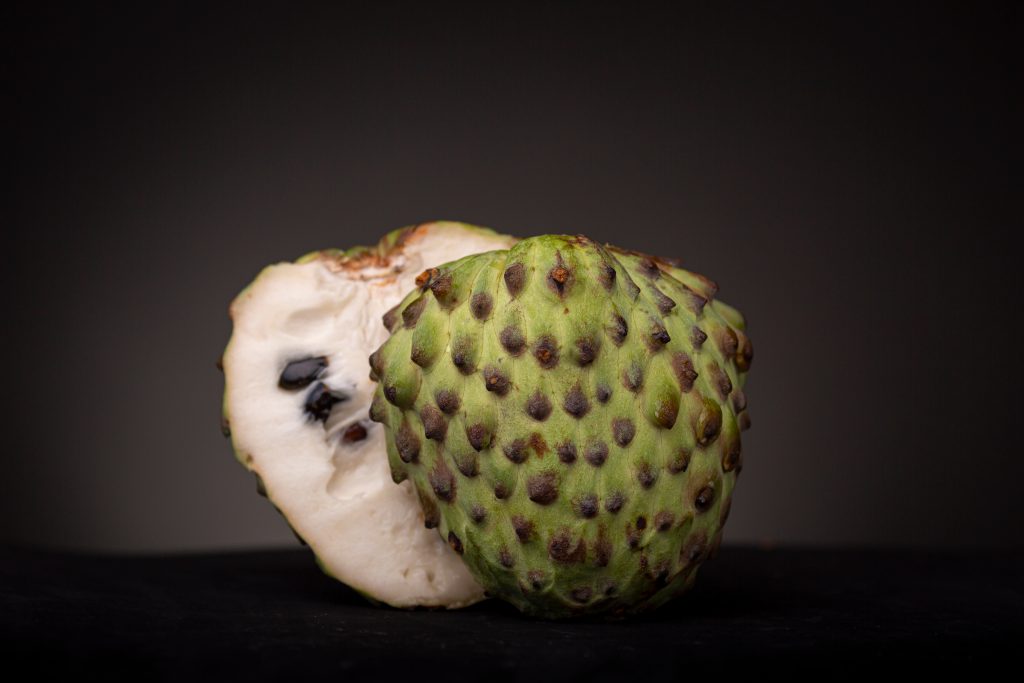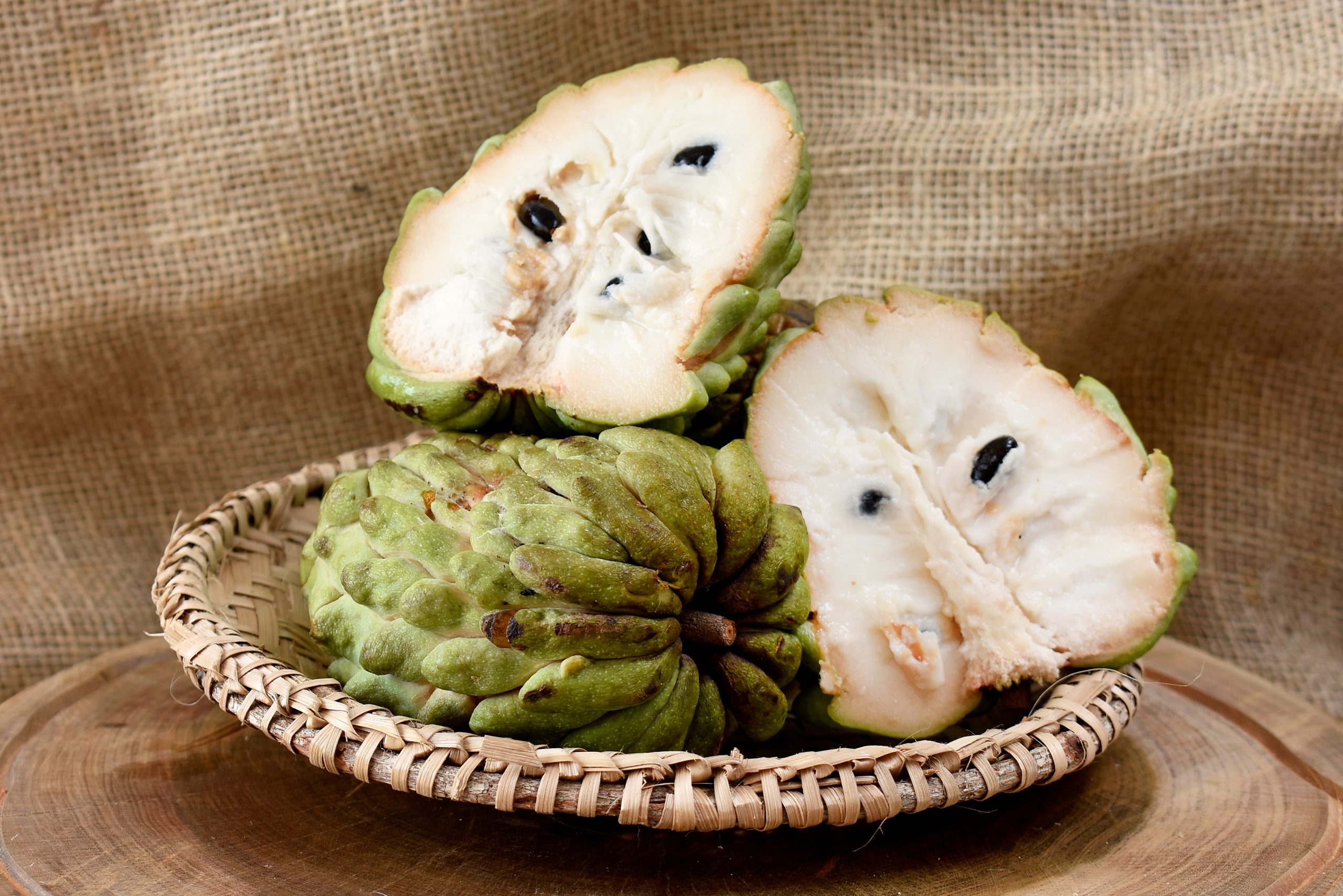Atemoya is a unique and delectable fruit hybrid of the custard apple and the cherimoya. With its smooth green skin, creamy white flesh, and sweet tropical flavor, the atemoya has gained popularity for its distinctive taste and nutritional benefits.
Table of Contents
What is Atemoya?
Atemoya is a tropical fruit that belongs to the Annonaceae family. It is a hybrid fruit resulting from a cross between the sugar apple (Annona squamosa) and the cherimoya (Annona cherimola).
Atemoya is also known by various names such as custard apple, cherimoya custard apple, or pineapple sugar apple. It’s also named Annona × atemoya, or Annona squamosa × Annona cherimola.
This delightful fruit tree is believed to have originated in Central America, specifically in the lowland tropical areas of Mexico, Guatemala, and El Salvador. It was later introduced to other tropical regions worldwide, including parts of Asia, Africa, and the Caribbean. Today, the atemoya tree is cultivated in several countries with suitable climates, including the United States (South Florida), Australia, Israel, and Brazil.
Visually, the atemoya fruit is typically heart-shaped or oval-shaped and can weigh anywhere from a few ounces to several pounds, depending on the variety. Its outer skin is green and bumpy, similar to the sugar apple, but generally less pronounced.
The skin may become slightly yellow or brown as the fruit ripens. Inside, the flesh is creamy and white, with a texture that is often described as custard-like.
The flavor profile of atemoya is genuinely remarkable and is considered a tropical delicacy due to its unique blend of flavors. It is a combination of the sweet and tangy notes of the cherimoya, with the rich, creamy, and slightly sweet flavors reminiscent of the sugar apple.
Some people also taste hints of pineapple, vanilla, and pear. Atemoya offers a delightful balance of sweetness and acidity, making it a refreshing and satisfying fruit.
It is worth noting that atemoya is highly perishable and is best consumed when ripe. Some cultivars of atemoya include Bradley, Geffner, Pink’s Mammoth, Priestly, Malanud, Kabri, Cherimata, and African Pride.
The History of Atemoya
The fruit came to be thanks to a horticulturist named P.J. Wester when he created the first ever atemoya hybrid in a USDA laboratory in Miami in 1908. The resulting fruits were considered even better than the sugar apple.
However, the pioneering atemoya was introduced to the beautiful archipelago of the Philippines. The atemoya has since traveled to the vibrant jungles of South America, the spirit-filled islands of Hawaii, the ancient lands of Israel, Australia, and New Zealand, the rich soils of South Africa, and finally, the historic sands of Egypt.
These Atempya were not the most bountiful of fruit-bearers: Gardeners took upon themselves the role of stimulating more fruit growth by hand pollination.

What Does Atemoya Taste Like?
As mentioned, atemoya has a unique flavor profile that can be described as a combination of various tropical fruits.
When consumed raw, its taste is described as a sweet blend of flavors, including hints of pineapple, banana, vanilla, and pear. The flesh of the fruit is smooth and creamy, with a slightly grainy texture due to the presence of tiny black seeds. The flavor is generally delightful, with a lovely sweetness.
Atemoya can be used in culinary preparations such as desserts, jams, and sauces. Cooking atemoya can alter its texture and flavor. When heated, the fruit may become softer and more tender, and the flavors can become more concentrated.
How to Tell When Atemoya is Ripe
To determine if an atemoya fruit is ripe, here are some essential characteristics to consider:
| Color | Look for a change in the fruit’s color from green to a light yellowish or creamy tone. The skin should have a slight give when gently pressed. |
| Texture | The skin of a ripe atemoya should feel slightly soft and smooth to the touch. Avoid fruits with wrinkled or overly soft skin. |
| Scent | Ripe Atemoya fruits emit a sweet, fragrant aroma. If the fruit has a pleasant smell, it is likely ripe. |
Are Atemoyas and Cherimoyas Related?


Atemoyas and cherimoyas are related as they belong to the Annonaceae family, commonly called the custard apple family. While they share some similarities, there are also notable differences between these two fruits. Let’s explore their primary similarities and differences:
Similarities
| Family | Atemoyas and cherimoyas belong to the same botanical family, Annonaceae, which comprises numerous tropical fruit-bearing plants. |
| Origin | Both fruits are native to the tropical regions of Central and South America, particularly in countries like Peru, Ecuador, and Colombia. |
| Appearance | Both fruits have a similar overall shape and size. They are typically round or heart-shaped, with a green outer skin that turns yellow or brown when ripe. |
| Flavor and Taste | Atemoyas and cherimoyas are known for their sweet and creamy flavor. They are often described as having a taste similar to a blend of fruits, including banana, pineapple, and strawberry. |
Differences
| Hybrid Origin | Atemoya is a hybrid fruit from a cross between cherimoya (Annona cherimola) and sugar apple (Annona squamosa, also known by the old Mexican name “ate”). On the other hand, cherimoya is a distinct fruit species (Annona cherimola) in its own right. |
| Fruit Skin Texture | Atemoyas typically have smoother and more bumpy skin than cherimoyas’ rough, scaly surface. |
| Flavor Variations | While both fruits share a sweet and creamy flavor, cherimoyas are generally considered to have a more complex and nuanced taste. Some describe the flavor of cherimoya as having hints of vanilla, mango, and pear. |
| Seed Size and Quantity | Atemoyas have more extensive and abundant seeds than cherimoyas. The seeds of cherimoya are usually smaller and fewer in number. |
| Availability and Cultivation | Atemoyas are relatively more widely cultivated and available in different regions than cherimoyas, grown in more limited areas. |
Cooking with Atemoya
Cooking with atemoya can be an exciting way to try something new and add a tropical flair to your meals.
Before you can use atemoya in your cooking, you need to know how to prepare it properly:
- First, pick a ripe atemoya. It should give slightly when squeezed gently, much like an avocado. The skin should be pale to dark green with no signs of bruising or punctures.
- Use a sharp knife to slice the fruit in half. The inside of the atemoya is filled with a creamy, custard-like pulp.
- You’ll notice that the atemoya has numerous black seeds scattered throughout its flesh. These seeds are inedible and need to be removed. Scoop them out with a spoon or your fingers.
- You can scoop the flesh once the seeds are removed and use it in your recipes. The skin is not edible, so be sure to discard it.
While atemoya is delicious raw, it can also be used in various dishes, especially in Central and South America, the Caribbean, and Southeast Asia cuisine. You can also use sugar apple recipes and substitute just the fruit.
Here are a few examples of how you can cook with atemoya:
Atemoya Smoothie: This simple and healthy treat is perfect for breakfast or a snack. Blend the pulp of the atemoya with some yogurt, a bit of milk (dairy or non-dairy alternatives work), and a drizzle of honey. Add a banana for extra creaminess and sweetness if you like.
Atemoya Sorbet: Create a simple syrup by boiling sugar and water, let it cool, then blend it with the atemoya pulp and some lemon juice. Freeze the mixture until solid, then mix it for a smooth and refreshing sorbet.
Atemoya Salsa: For a tropical twist on traditional salsa, mix diced atemoya with chopped onion, jalapeño, cilantro, lime juice, and a dash of salt. It’s the perfect accompaniment to grilled fish or chicken.
Atemoya Upside-Down Cake: Substitute atemoya for pineapple in a traditional pineapple upside-down cake recipe for a deliciously unique dessert.
How to Store Atemoya
Atemoya is a tropical fruit that requires special care when storing. Here are the different ways to keep atemoya and their associated shelf life:
| On the Counter | Atemoya can be left on the counter until it ripens. It is ripe when it yields to gentle pressure and may develop slight browning and a sweet, aromatic smell. This could take a few days up to a week, depending on the initial ripeness. |
| In the Refrigerator | Once ripe, the atemoya should be eaten or refrigerated immediately to slow the ripening process. It can last about 3-5 days when stored in the refrigerator. Place the fruit in a plastic bag or wrap it loosely in plastic to prevent moisture loss. |
| Freezing | Atemoya can be frozen for long-term storage. To do this, remove the skin and seeds, cut the fruit into pieces, and store it in a freezer-safe bag or container. This way, it can last for up to 12 months. |
Note: the texture will change upon thawing, so frozen atemoya is best used in cooked dishes, smoothies, or desserts.
Nutritional Benefits of Atemoya
Atemoyas are particularly rich in vitamin C, which helps protect cells from damage caused by harmful free radicals, supporting the immune system, promoting iron absorption, and contributing to collagen synthesis.
Atemoyas are also a good source of dietary fiber, reducing the risk of constipation, improving gut health, and lowering cholesterol levels.
Atemoyas contain some calcium, which helps maintain strong bones and teeth, muscle function, nerve transmission, and blood clotting. The iron in atemoya is essential for oxygen transport throughout the body.
Where to Purchase Atemoya
Some larger specialty grocery stores or gourmet markets may carry atemoya, especially those focusing on exotic fruits. Local farmers’ markets can be a great place to find atemoya, especially if you live in a region with a tropical or subtropical climate. You can explore online markets and exotic fruit suppliers if you cannot find them locally.
The best time of year to find atemoya can vary depending on the growing region. atemoya is more commonly available during warmer months in tropical and subtropical areas. However, availability may also depend on local harvest seasons and importation from other countries.

